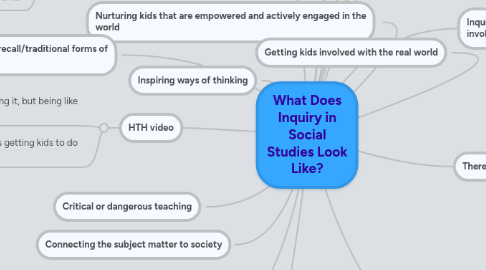
1. Connecting the subject matter to society
2. Resources for teachers
2.1. thinkinginmind.com
2.2. calgaryscienceschool.blogspot.com
2.3. twitter
3. Academic rigor
3.1. 1. The critical thinking consortium
3.1.1. a. Making judgements on evidence/criteria
3.1.2. b. Analyzing and sourcing info
3.1.3. c. Analyzing images
3.2. 2. Benchmarks of historical thinking
3.2.1. a. Establish historical significance
3.2.2. b. Use primary source evidence
3.2.3. c. Identify continuity and change
3.2.4. d. Analyze cause and consequence
3.2.5. e. Take historical perspectives
3.2.6. f. Understand ethical dimensions of history
3.3. 3. Throughline questioning
3.3.1. Ask provocative and relevant questions that encourage teachers and students to make connections
4. Critical or dangerous teaching
5. HTH video
5.1. "I want kids behaving like an actress, scientist, documentary filmmaker, like a journalist. Not just studying it, but being like it."
5.2. "Inquiry is about kids learning to behave, act and think in the ways of the discipline. Instead of teaching math, its about teaching mathematical thinking. It's not teaching science, its getting kids to do science. "
6. Nurturing kids that are empowered and actively engaged in the world
7. Using authentic questions and topics
7.1. The ring road in Calgary
7.1.1. The students made a website for the community
7.1.2. They talked to community members
7.1.3. They used news stories
7.1.4. They went public so people in the community could use it
7.1.5. They researched and produced something worth value to the community
7.2. Students hosted a forum for the mayoral candidates
7.2.1. Six candidates came to the forum
7.2.2. They used livestream.com to broadcast it
7.2.3. Over 2000 people watched it
7.2.4. The students were upset because they learned that most college kids don’t vote and they wanted to vote. The grade 9 students went around and tried to convince college students to vote.
7.2.4.1. They were successful
7.2.5. All of their knowledge and research left the classroom and went into the community
7.2.6. This project resulted in kids being excited and informed about politics
7.3. Putting adolescent kids with recent immigrants
7.3.1. Students documenting/recoding immigrants travels/struggles
7.3.2. Students were given the task of figuring out the values or worldview of another country. They made images that they thought represented a certain country's values/worldview. They then sat down with someone from that culture to discuss the student's work. The students began to realize how difficult it really is to understand other cultures.
